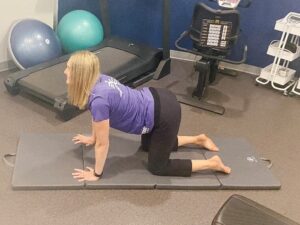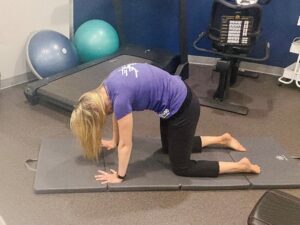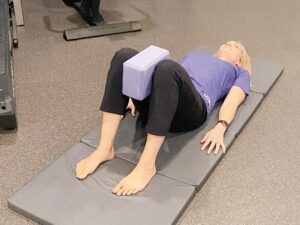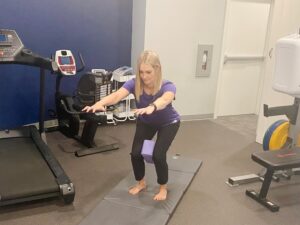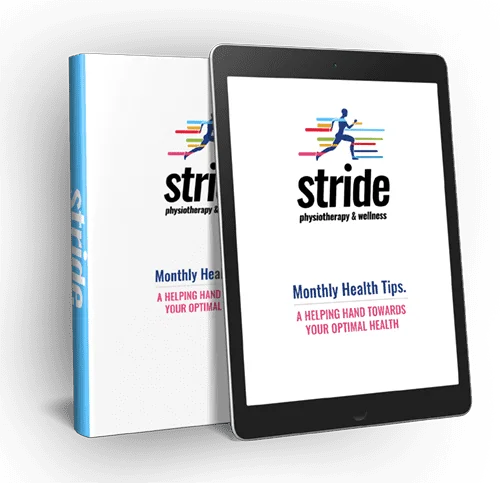Pelvic Pain During Pregnancy: Is it Common?
By: Jen Goehring, Physiotherapist
Pregnancy can be a wonderful time for many women, but it can also come with its fair share of aches and pains. One of the most common complaints pelvic physiotherapists hear among pregnant women is pelvic pain. In fact, 1 in 5 women who are pregnant will experience pelvic pain during some part of their pregnancy. The good news is that pelvic physio provides many treatments, activity modifications, and key exercises that can assist you in navigating your pregnancy pelvic pain.
What Are the Causes of Pelvic Pain During Pregnancy?
Although the exact reason for pelvic pain during pregnancy is unknown, there are a few factors that may contribute. These include:
-
Pubic Symphysis Dysfunction (SPD)
Pain on the front of the pelvis can occur if the pelvic joints become misaligned or unstable, which is common during pregnancy. Pubic Symphysis Dysfunction often presents as a sharp pain with things like walking, climbing stairs, rolling in bed, or standing on one leg to put shoes on. Clicking, grinding, and popping may also occur.
-
Pelvic Girdle Pain (PGP)
Pelvic Girdle Pain is another common cause of pelvic pain during pregnancy. It can present as pain in the lower back, hips, and pelvis which can make it difficult to walk, move around, and perform daily activities.
-
Round Ligament Pain
Round ligament pain occurs during different stages of pregnancy where the ligaments that support the uterus stretch, pull, and expand. Round ligament pain can cause sharp, stabbing, or dull pain on one or both sides of the lower abdomen. It can also feel like strong Braxton Hicks contractions.
There are other causes of discomfort in the pelvis during pregnancy. If you’re ever concerned about your pregnancy or the level of pain you are experiencing, please reach out to your doctor directly. If it is not an emergency, contact us for a pelvic health assessment with one of our physiotherapists.
What Are the Common Symptoms of Pelvic Pain During Pregnancy?
While pelvic pain can be uncomfortable, it is typically not a cause for concern. The following are common symptoms you might experience if you have pelvic pain during pregnancy.
- Pain around your pubic symphysis
- Clicking, grinding, or popping in your pubic area
- Lower back pain that may radiate into one of your legs
- Deep pain or pressure around your perineum
- Pain in your thighs or groin area
Four Tips to Reduce Pelvic Pain During Pregnancy
Treatment options for this kind of pain can vary, so it is important to speak with your physiotherapist to determine the best plan for you. Some ideas that might help alleviate pelvic pain during pregnancy are:
- Heat: Using a heating pad on the pelvic area can help to relax muscle tension and reduce pain. Taking a warm shower or bath may also help.
- Rest: Rest when you are able. If rest isn’t an option, then modifying activities that are painful may help. This would include: equipment support, postural changes, or focused exercises. Sit to put your shoes on, avoid carrying heavy things on one side of the body, or reduce the time spent on your feet.
- Belt: A SI joint belt can be very helpful for lower back or pubic pain, especially with walking and standing.
- Pregnancy Pillow: A pregnancy pillow can provide support to the lower back and pelvic area while resting or sleeping.
Four Exercises to Reduce Pelvic Pain During Pregnancy
The four exercises below are designed to help reduce pain in the pelvic area. The goal of each of these exercises is to promote force closure of the pelvis. This means that we are working on engaging all of the muscles around the pelvis to provide stability to the pelvis and reduce pain with movement.
1. Cat-Cow Exercise
- Start on your hands and knees with your wrists under your shoulders.
- Arch your back lifting your head up and pushing your tailbone out. Hold this position for 5-10 seconds.
- Bend your back by tucking your head and tailbone in, making a curve in your back. Hold this position for 5-10 seconds.
- Repeat 10 times.
2. Bridge
- Lie on your back with your knees bent and your feet flat on the floor.
- Take a block or ball and squeeze it between your knees (you are welcome to go without the block if you prefer as shown in the first picture).
- Maintaining the squeeze on the block or ball, lift your hips up keeping them level. Hold for 1-2 seconds. (Try not to hyper-extend through your back.)
- Lower down to your starting position.
- Repeat 3 sets of 8 repetitions.
3. Butterfly
- Lie on your back and bend both of your knees up. Slowly open your hips, dropping both knees out to the sides and bringing the soles of your feet together.
- Ensure you squeeze your buttock muscles in this open position. Hold for 10 seconds.
- Repeat 3-5 times.
- Once the stretch is complete, straighten your legs out.
4. Squat
- With your feet shoulder width apart, place a small block or ball between your knees and gently squeeze it.
- Squat down, dropping your hips towards the floor and bending your knees.
- Stand back up, ensuring you continue to squeeze the ball or block and squeeze your buttock muscles.
- Repeat 3 sets of 8 repetitions.
If you continue to experience pelvic pain during pregnancy, feel free to book a Pelvic Health Assessment with our physiotherapist, Jen by clicking here.


